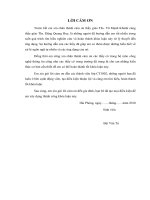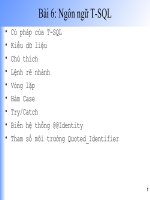Bài 6 giới thiệu ngôn ngữ t SQL
Bạn đang xem bản rút gọn của tài liệu. Xem và tải ngay bản đầy đủ của tài liệu tại đây (1.14 MB, 46 trang )
1
Bài 6: Ngôn ngữ T-SQL
•
Cú pháp của T-SQL
•
Kiểu dữ liệu
•
Chú thích
•
Lệnh rẽ nhánh
•
Vòng lặp
•
Hàm Case
•
Try/Catch
•
Biến hệ thống @@Identity
•
Tham số môi trường Quoted_Identifier
2
Cú pháp của T-SQL
Identifiers – Các định danh
Cách đặt tên table, view, stored procedure,
index,tên biến,…
- có thể dài từ 1 đến 128 ký tự theo mã Unicode
(gồm chữ cái, chữ số, ký hiệu)
- ký tự đầu tiên phải là: chữ cái hoặc @,#,_, or
$ .
- có thể sử dụng khoảng trắng trong các định
danh, tuy nhiên để truy cập các định danh này
bạn phải đặt nó trong dấu nháy kép hoặc ngoặc
vuông [].
VD: 7007Customers; @Variable; #tblTMP; [Ho va Ten]
Database Object Qualifiers – Định danh đầy đủ của
một đối tượng CSDL:
[[[server.][database].][schema].]database_object
3
Kiểu dữ liệu
4
Kiểu dữ liệu TimesTamp - 4 byte
- Trường kiểu TimesTamp được tự động cập nhật
mỗi khi bản ghi đó bị thay đổi.
VD: Ta có bảng nhân viên có rất nhiều thông tin
(hoten, ngaysinh, diachi, capbac, chucvu,
luong,…, TM TimesTamp). Các thông tin về cấp
bậc, chức vụ, lương có thể thay đổi liên tục.
Xác định nhân viên có sự thay đổi gần đây nhất:
Select * from NhanVien where TM in (select
max(TM) from NhanVien)
5
Uniqueidentifier – 16 bytes
Giá trị mà uniqueidentifier lưu trữ còn được gọi
lại globally unique identifiers (GUIDs). Giá trị
GUIDs đảm bảo là duy nhất trên toàn thế giới.
GUIDs are generated using the identification number
of the network card and a unique number obtained
from the computer's clock.
CREATE TABLE MyUniqueTable
(UniqueColumn UNIQUEIDENTIFIER DEFAULT
NEWID(),
Characters VARCHAR(10) )
GO
INSERT INTO MyUniqueTable(Characters) VALUES ('abc')
INSERT INTO MyUniqueTable VALUES (NEWID(), 'def')
GO
6
Kiểu dữ liệu XML
Create table dbo.TableXML(
Id int,
CompList xml)
go
INSERT INTO dbo.TableXML(Id, CompList)
VALUES(123,'<CompList><CZ101/><AZ401/><BZ407/><
/CompList>')
7
Biến trong SQL Server 2005
Khai báo:
Cú pháp: Declare @tenbien
<kieudulieu>[,@tenbien <kieudulieu> …]
VD: declare @dem int , @tong int
Gán giá trị cho biến:
Dùng lệnh SET:
Set @dem=10
Set @tong=@tong+1
Dùng lệnh Select:
Select @dem=10
Select @tong=@tong+1
In giá trị của biến:
Select @dem
Print @dem
8
Biến trong SQL Server 2005 (2)
Gán giá trị cho biến trong lệnh Update
use asset5
go
declare @mnsCost smallmoney
Update Inventory
Set @mnsCost = Cost = Cost *2
Where InventoryId = 6
9
Các lệnh cơ bản của T-SQL
•
Chú thích
–
Chú thích dòng đơn: chú thích
–
Chú thích nhiều dòng: /* nhiều dòng chú
thích */
•
Góm nhóm các câu lệnh thành một khối
BEGIN
{sql_statement|statement_block}
END
•
Lệnh nhảy GOTO
Label:
GOTO label
10
Lệnh rẽ nhánh
Cú pháp: IF Boolean_expression
{sql_statement|statement_block}
[ELSE
{sql_statement|statement_block}]
declare @i float
select @i=RAND() RAND() tra ve gia tri kieu float
0-1
print 'gia tri nhan duoc ' + cast(@i as varchar(10))
if (@i>0.5)
Begin
print 'Gia tri lon hon 0.5'
print '!!!'
End else
print 'Gia tri nho hon 0.5'
11
Ví dụ: Kết hợp GOTO và IF
declare @i float
Lap:
select @i=RAND()
RAND() tra ve gia tri kieu float 0-1
print 'Gia tri nhan duoc ' + cast(@i as
varchar(10))
if (@i>0.5)
Begin
print 'Gia tri lon hon 0.5'
print '!!!'
goto lap
End
Else print 'Gia tri nho hon 0.5'
12
Vòng lặp While
WHILE Boolean_condition
{sql_statement|statement_block}
[BREAK]
{sql_statement|statement_block}
[CONTINUE]
DECLARE @counter smallint
SET @counter = 1
WHILE @counter < 5
BEGIN
SELECT @counter [So thu tu],
RAND(@counter) Random_Number
SET @counter = @counter + 1
END
13
Break - Thoát khỏi vòng WHILE
DECLARE @counter smallint
SET @counter = 1
WHILE @counter < 10
BEGIN
SELECT @counter [So thu tu],
RAND(@counter) Random_Number
SET @counter = @counter + 1
if @counter>=5
break
END
14
CONTINUE -Tiếp tục vòng WHILE
DECLARE @counter smallint
DECLARE @c2 smallint
SET @counter = 1
set @c2=1
WHILE @counter < 10
BEGIN
SELECT @c2 [So thu tu], RAND(@counter)
Random_Number
set @c2=@c2+1
if @c2>50
break
if @counter>=5
continue
SET @counter = @counter + 1
END
Print ‘Gia tri cua counter=’ + cast (@counter as
varchar(10))
15
Hàm CASE
Cú pháp 1:
CASE <input_expression>
WHEN when_expression THEN
result_expression
[WHEN …]
[ ELSE else_result_expression ]
END
Cú pháp 2:
CASE
WHEN Boolean_expression THEN
result_expression
[WHEN ]
[ ELSE else_result_expression ]
END
16
Hàm CASE (2)
declare @st varchar(100)
declare @i float
set @i=RAND()
SELECT @st =
CASE
WHEN @i<0.2 THEN 'Gia tri nho hon
0.2'
WHEN @i<0.4 THEN 'Gia tri nho hon 0.4'
ELSE
'Cac gia tri khac'
END
print @st
17
Hàm CASE (3)
USE AdventureWorks;
GO
SELECT ProductNumber, Category =
CASE ProductLine
WHEN 'R' THEN 'Road'
WHEN 'M' THEN 'Mountain'
WHEN 'T' THEN 'Touring'
WHEN 'S' THEN 'Other sale items'
ELSE 'Not for sale'
END, Name FROM Production.Product
ORDER BY ProductNumber;GO
18
Hàm CASE (4)
USE AdventureWorks;GO
SELECT ProductNumber, Name, 'Price Range' =
CASE
WHEN ListPrice = 0 THEN 'Mfg item - not for
resale'
WHEN ListPrice < 50 THEN 'Under $50'
WHEN ListPrice >= 50 and ListPrice < 250 THEN
'Under $250'
WHEN ListPrice >= 250 and ListPrice < 1000
THEN 'Under $1000'
ELSE 'Over $1000'
END
FROM Production.Product
ORDER BY ProductNumber ;
GO
19
WAITFOR {DELAY 'time'|TIME 'time'}
DELAY 'time‘ – khoảng thời gian mà SQL Server
phải chờ.
TIME 'time' – yêu cầu SQL Server chờ đến
thời điểm chỉ định.
Ví dụ:
WAITFOR Time '12:47:00'
Print ‘Câu lệnh này chỉ được chạy sau
12:47:00'
WAITFOR Delay '00:00:01’
20
WAITFOR {DELAY 'time'|TIME 'time'}
Use tempdb go
alter PROCEDURE time_delay @@DELAYLENGTH char(8)
AS
DECLARE @@RETURNINFO varchar(255)
BEGIN
WAITFOR DELAY @@DELAYLENGTH
SELECT @@RETURNINFO = 'A total time of ' +
SUBSTRING(@@DELAYLENGTH, 1, 2) +
' hours, ' +
SUBSTRING(@@DELAYLENGTH, 4, 2) +
' minutes, and ' +
SUBSTRING(@@DELAYLENGTH, 7, 2) +
' seconds, ' +
'has elapsed! Your time is up.'
PRINT @@RETURNINFO
END GO
EXEC time_delay '00:00:10'
21
Try/Catch
Cú pháp:
BEGIN TRY
{ sql_statement | statement_block }
END TRY
BEGIN CATCH
{ sql_statement | statement_block }
END CATCH [ ; ]
22
try/catch phải trong một batch
Ví dụ: Đoạn code sau sẽ phát sinh lỗi
BEGIN TRY
SELECT * FROM sys.messages
WHERE message_id = 21;
END TRY
GO
BEGIN CATCH
SELECT ERROR_NUMBER() AS ErrorNumber;
END CATCH;
GO
23
Các Error Functions
ERROR_NUMBER() returns the error number.
ERROR_MESSAGE() returns the complete text of the error
message. The text includes the values supplied for
any substitutable parameters such as lengths, object
names, or times.
ERROR_SEVERITY() returns the error severity. (Trả về
sự nghiêm trọng của lỗi)
ERROR_STATE() returns the error state number.
ERROR_LINE() returns the line number inside the
routine that caused the error.
ERROR_PROCEDURE() returns the name of the stored
procedure or trigger where the error occurred.
24
Severity Description
0-9
Informational messages that return status information or report errors that are not severe. The Database Engine
does not raise system errors with severities of 0 through 9.
10
Informational messages that return status information or report errors that are not severe. For compatibility
reasons, the Database Engine converts severity 10 to severity 0 before returning the error information to
the calling application.
11-16 Indicate errors that can be corrected by the user.
11 Indicates that the given object or entity does not exist.
12
A special severity for queries that do not use locking because of special query hints. In some cases, read
operations performed by these statements could result in inconsistent data, since locks are not taken to
guarantee consistency.
13 Indicates transaction deadlock errors.
14 Indicates security-related errors, such as permission denied.
15 Indicates syntax errors in the Transact-SQL command.
16 Indicates general errors that can be corrected by the user.
17-19 Indicate software errors that cannot be corrected by the user. Inform your system administrator of the problem.
17
Indicates that the statement caused SQL Server to run out of resources (such as memory, locks, or disk space
for the database) or to exceed some limit set by the system administrator.
18
Indicates a problem in the Database Engine software, but the statement completes execution, and the
connection to the instance of the Database Engine is maintained. The system administrator should be
informed every time a message with a severity level of 18 occurs.
Severity Level
25
Severity Description
19
Indicates that a nonconfigurable Database Engine limit has been exceeded and the current batch process has
been terminated. Error messages with a severity level of 19 or higher stop the execution of the current batch.
Severity level 19 errors are rare and must be corrected by the system administrator or your primary support
provider. Contact your system administrator when a message with a severity level 19 is raised. Error
messages with a severity level from 19 through 25 are written to the error log.
20-25
Indicate system problems and are fatal errors, which means that the Database Engine task that is executing a statement or batch
is no longer running. The task records information about what occurred and then terminates. In most cases, the application
connection to the instance of the Database Engine may also terminate. If this happens, depending on the problem, the
application might not be able to reconnect.
Error messages in this range can affect all of the processes accessing data in the same database and may indicate that a
database or object is damaged. Error messages with a severity level from 19 through 25 are written to the error log.
20
Indicates that a statement has encountered a problem. Because the problem has affected only the current task, it is unlikely that
the database itself has been damaged.
21
Indicates that a problem has been encountered that affects all tasks in the current database, but it is unlikely that the database
itself has been damaged.
22
Indicates that the table or index specified in the message has been damaged by a software or hardware problem.
Severity level 22 errors occur rarely. If one occurs, run DBCC CHECKDB to determine whether other objects in the database
are also damaged. The problem might be in the buffer cache only and not on the disk itself. If so, restarting the instance of the
Database Engine corrects the problem. To continue working, you must reconnect to the instance of the Database Engine;
otherwise, use DBCC to repair the problem. In some cases, you may have to restore the database.
If restarting the instance of the Database Engine does not correct the problem, then the problem is on the disk. Sometimes
destroying the object specified in the error message can solve the problem. For example, if the message reports that the
instance of the Database Engine has found a row with a length of 0 in a nonclustered index, delete the index and rebuild it.
23
Indicates that the integrity of the entire database is in question because of a hardware or software problem.
Severity level 23 errors occur rarely. If one occurs, run DBCC CHECKDB to determine the extent of the damage. The problem
might be in the cache only and not on the disk itself. If so, restarting the instance of the Database Engine corrects the problem.
To continue working, you must reconnect to the instance of the Database Engine; otherwise, use DBCC to repair the problem.
In some cases, you may have to restore the database.
24
Indicates a media failure. The system administrator may have to restore the database. You may also have to call your hardware
vendor.









